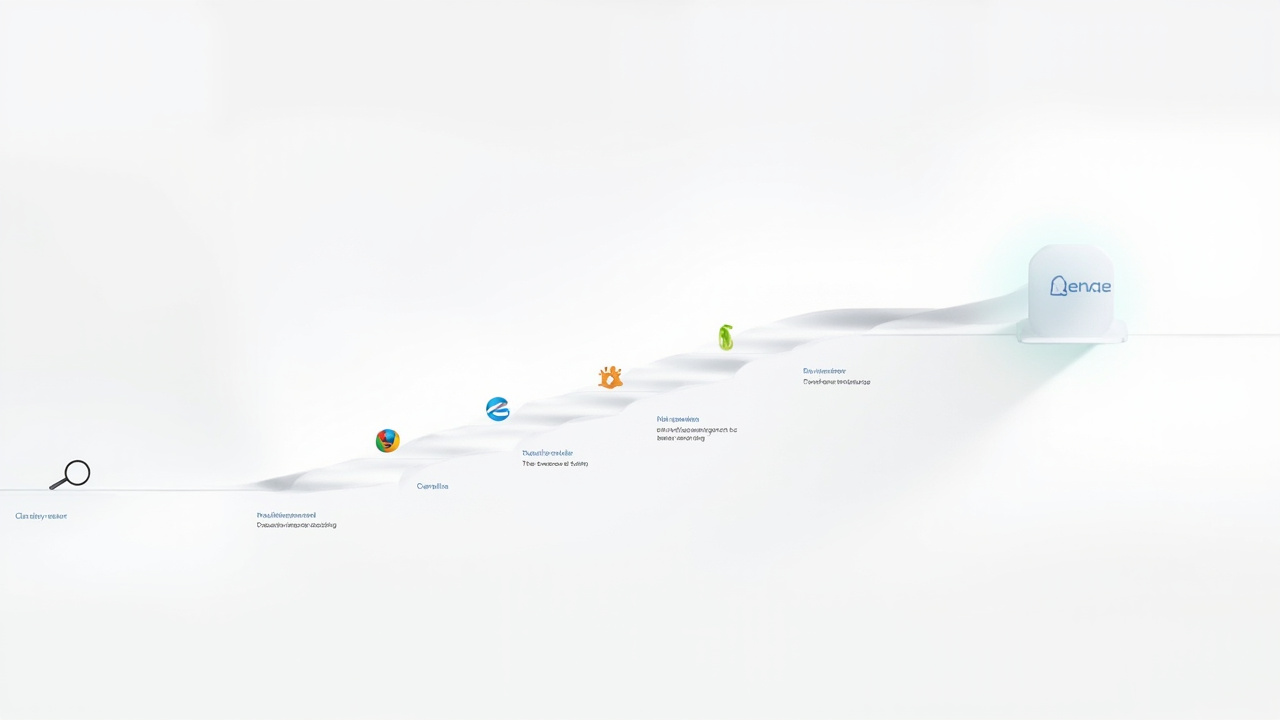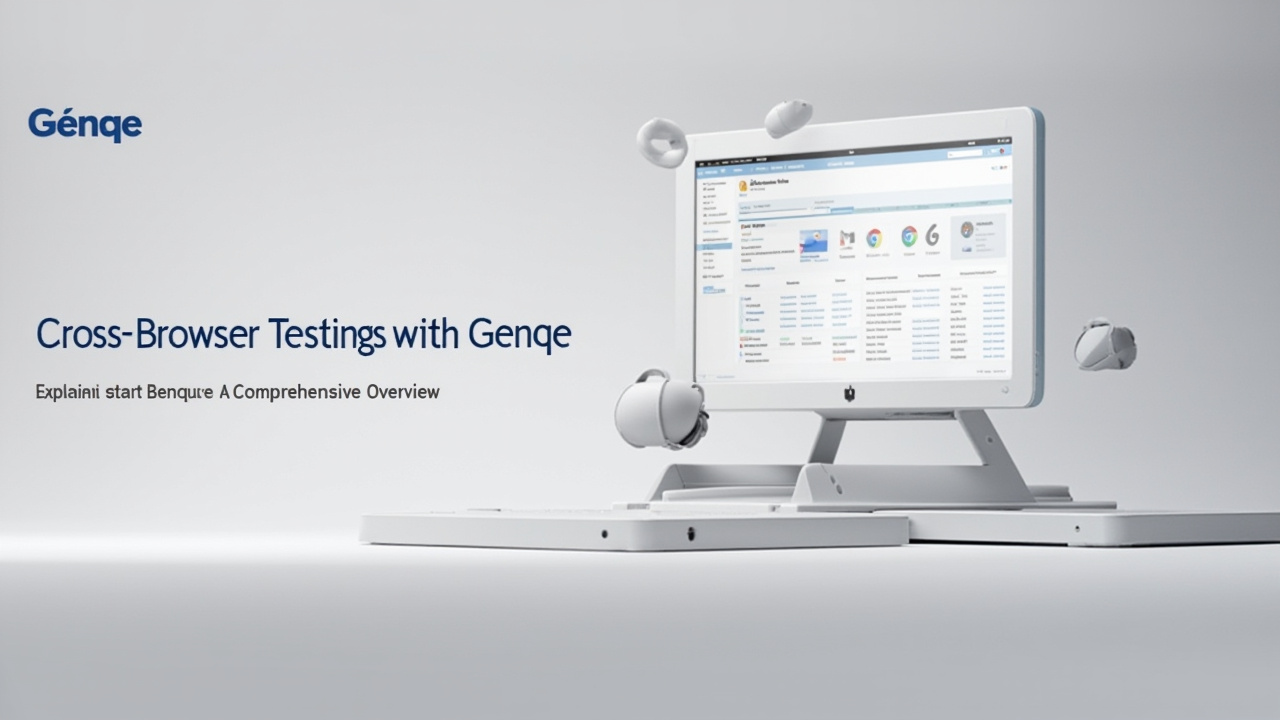In today’s digital landscape, the seamless operation of websites and web applications across various browsers is more crucial than ever. As users increasingly access content via a myriad of browser options, ensuring a consistent and smooth user experience is paramount. This is where cross-browser testing becomes indispensable. Among the various tools available for this purpose, Genqe has emerged as a noteworthy contender. But what makes Genqe stand out, and how can it transform your approach to cross-browser testing?
In this comprehensive guide, we delve deep into the world of cross-browser testing with Genqe, unraveling its features, benefits, and the pivotal role it plays in web development today. Whether you’re a seasoned developer or a newcomer to the field, this article will equip you with valuable insights and practical knowledge to enhance your testing strategy.
Understanding the intricacies of cross-browser testing is essential for overcoming the challenges associated with browser incompatibility. With the rapid evolution of web technologies, developers must ensure that their applications not only function correctly but also deliver a uniform experience across all platforms. As we navigate through this article, you’ll discover how Genqe simplifies this process, providing a robust solution for modern web development.
The Evolution of Cross-Browser Testing

Cross-browser testing has come a long way since the early days of web development. Initially, developers encountered myriad issues as new browsers emerged and existing ones updated their engines. The diversity in how browsers interpret HTML, CSS, and JavaScript led to inconsistencies in website rendering and functionality.
The Historical Perspective
In the past, developers were constrained by limited tools and resources, often resorting to manual testing methods. This labor-intensive process involved checking each web page on different browsers and platforms to identify discrepancies. As the web grew, so did the complexity of ensuring compatibility, necessitating the development of automated testing tools.
Manual testing, though reliable to an extent, was fraught with challenges. Developers had to maintain multiple physical devices, each running different browsers and operating systems. This setup was not only costly but also time-consuming. Moreover, as the number of browsers increased, so did the challenge of maintaining a consistent user experience across all platforms. The introduction of automated testing tools marked a significant shift in the industry, reducing the reliance on manual methods and paving the way for more efficient testing processes.
The Need for Robust Solutions
Modern web applications require sophisticated testing methodologies capable of handling complex scenarios. With users expecting flawless performance across devices and browsers, developers can no longer afford to rely solely on traditional methods. The rise of responsive design and progressive web apps has further compounded the need for comprehensive testing solutions.
Imagine a scenario where a web application performs perfectly on a desktop browser, but certain features break when accessed via a mobile browser. This kind of inconsistency can lead to user frustration and potential loss of business. As such, developers need robust solutions that can simulate real-world usage conditions and identify potential issues before they reach end-users. Genqe is designed to address these challenges, offering a comprehensive testing suite that caters to the diverse needs of modern web applications.
“In today’s fast-paced digital world, cross-browser testing is not optional; it’s essential.”
The Role of Automation
Automation has revolutionized cross-browser testing, enabling developers to conduct extensive tests in significantly less time. Tools like Genqe leverage automation to streamline the testing process, allowing for rapid identification and resolution of compatibility issues. As we explore Genqe’s features, we’ll see how it addresses the contemporary challenges of cross-browser testing.
Automation not only speeds up the testing process but also enhances its accuracy. By removing the human element from repetitive tasks, automated tools reduce the likelihood of errors and improve the reliability of test results. Moreover, automation allows for continuous testing, integrating seamlessly into the development pipeline and providing real-time feedback to developers. This capability is particularly valuable in agile development environments, where rapid iteration and deployment are key.
Exploring Genqe: A Comprehensive Overview

Genqe is designed to simplify and enhance the cross-browser testing process. Its robust features and user-friendly interface make it a preferred choice for developers seeking efficiency and accuracy.
Key Features of Genqe
Genqe offers a range of features tailored to meet the diverse needs of web developers. These include
- Automated Testing: Genqe’s automation capabilities allow for extensive testing across multiple browsers, ensuring comprehensive coverage without the need for manual intervention. This feature enables developers to schedule tests at regular intervals, ensuring that any new code does not introduce compatibility issues.
- Real-Time Testing: With Genqe, developers can conduct real-time testing, observing how their applications perform across different browsers instantly. This feature is particularly useful for troubleshooting issues as they arise, enabling rapid resolution and minimizing downtime.
- Flexible Integration: Genqe easily integrates with various development environments and CI/CD pipelines, streamlining the workflow and enhancing productivity. This integration ensures that testing is an integral part of the development process, rather than an afterthought.
User Experience and Interface
One of Genqe’s standout features is its intuitive interface, designed to be accessible to both novice and experienced developers. The platform’s dashboard provides a clear overview of testing progress, results, and any detected issues, allowing for quick and efficient troubleshooting.
The interface is designed with usability in mind, featuring drag-and-drop functionality and customizable views. Developers can easily set up and manage tests, track results, and generate reports, all from a single, centralized platform. This level of accessibility reduces the learning curve associated with adopting new tools, enabling teams to get up and running quickly.
Genqe in Action
Consider a scenario where a developer needs to ensure that a new feature works seamlessly across all major browsers. With Genqe, they can set up automated tests that run simultaneously on multiple platforms, providing immediate feedback and highlighting any areas that require attention. This proactive approach minimizes downtime and enhances the overall quality of the application.
For instance, a retail company launching a new online shopping feature can use Genqe to test the feature’s functionality across different browsers and devices. By automating this process, the company can ensure that the feature works flawlessly for all users, regardless of their preferred browsing platform. This level of assurance is critical in maintaining customer satisfaction and trust.
“Genqe bridges the gap between development and deployment, ensuring flawless user experiences across the board.”
The Benefits of Using Genqe for Cross-Browser Testing

Utilizing a tool like Genqe offers numerous advantages that streamline the testing process and enhance the quality of web applications.
Efficiency and Speed
Genqe’s automation capabilities significantly reduce the time required for testing, allowing developers to focus on other critical tasks. By automating repetitive testing processes, Genqe ensures that developers can maintain high productivity levels without compromising on accuracy.
Automation not only saves time but also allows for more comprehensive testing. Developers can run a vast number of test cases in parallel, covering more scenarios than would be feasible with manual testing. This comprehensive approach ensures that applications are thoroughly vetted for compatibility issues, resulting in a more reliable end product.
Accurate Results
With Genqe, developers receive precise and reliable results, ensuring that any issues are quickly identified and resolved. This accuracy is crucial for maintaining the integrity of web applications as they scale and evolve.
Consider the example of a social media platform that updates its user interface. Using Genqe, developers can test the new interface across different browsers and devices, ensuring that all features work as intended. Accurate testing results allow the company to deploy the update confidently, knowing that users will have a consistent experience regardless of their browser choice.
Cost-Effectiveness
Investing in Genqe can lead to substantial cost savings in the long run. By identifying and fixing compatibility issues early in the development cycle, companies can avoid the costly repercussions of post-deployment errors, including user dissatisfaction and potential revenue loss.
In addition, Genqe’s automation capabilities reduce the need for extensive manual testing, freeing up valuable resources that can be allocated to other areas of development. This efficiency translates into cost savings, making Genqe a worthwhile investment for companies looking to optimize their testing processes.
Enhanced Collaboration
Genqe’s integration features promote seamless collaboration among development teams. By providing a centralized platform for testing results and insights, Genqe facilitates communication and coordination, ensuring that all team members are aligned and informed.
In a large organization with multiple development teams, Genqe acts as a single source of truth for testing results. Teams can easily share insights, track progress, and collaborate on resolving issues, leading to a more cohesive and efficient development process.
“Efficiency and accuracy are the hallmarks of Genqe’s cross-browser testing solution, empowering teams to deliver exceptional digital experiences.”
Implementing Genqe: A Step-by-Step Guide

Adopting Genqe into your development workflow can transform your approach to cross-browser testing. This section provides a practical guide to getting started with Genqe.
Setting Up Genqe
Begin by creating an account on the Genqe platform. Once registered, you’ll gain access to the dashboard, where you can configure your testing environment. Customize your settings based on the browsers and devices you wish to target.
The initial setup involves selecting the browsers and devices that are most relevant to your user base. Genqe offers a wide range of options, allowing you to tailor the testing environment to your specific needs. By focusing on the most commonly used browsers and devices, you can ensure that your application delivers a consistent experience to the majority of your users.
Creating Test Cases
Develop test cases that reflect the core functionalities of your web application. Genqe allows you to automate these tests, ensuring they run consistently across all specified browsers. Utilize Genqe’s scripting capabilities to simulate user interactions and capture any discrepancies.
When creating test cases, consider the user journeys that are most critical to your application. For example, if you’re developing an e-commerce platform, focus on the checkout process, product browsing, and user account management. By prioritizing these key areas, you can ensure that your application meets the needs of your users and delivers a seamless experience.
Analyzing Results
After executing your tests, review the results provided by Genqe. The platform highlights any compatibility issues, offering detailed insights and suggestions for improvement. Use this information to refine your code and enhance the user experience.
Genqe’s results analysis features allow you to drill down into specific issues, providing the context and data needed to implement effective solutions. By addressing these issues early in the development process, you can avoid costly post-deployment fixes and ensure a smooth user experience.
Continuous Integration
Incorporate Genqe into your CI/CD pipeline for ongoing testing and quality assurance. By continuously monitoring your application’s performance across browsers, you can promptly address any issues that arise during development.
Integrating Genqe into your CI/CD pipeline ensures that testing is an integral part of the development process. Automated tests can be triggered with each code commit, providing real-time feedback to developers and allowing for rapid iteration. This continuous testing approach helps maintain the quality and stability of your application as it evolves.
“Implementing Genqe is a strategic move that elevates your testing processes to a new level of precision and effectiveness.”
Overcoming Common Challenges with Genqe

While cross-browser testing is essential, it is not without its challenges. Genqe is designed to address common obstacles developers face, ensuring a smoother testing experience.
Addressing Browser-Specific Bugs
Browser-specific bugs are a notorious challenge in web development. Genqe’s extensive testing capabilities help identify these bugs early, allowing developers to implement fixes before they impact the end user.
Browser-specific bugs often arise from differences in how browsers interpret web standards. For example, a feature that works perfectly in Chrome might not render correctly in Safari. Genqe’s comprehensive testing ensures that these discrepancies are identified and addressed before deployment, minimizing the risk of user frustration.
Handling Responsive Design Issues
With the proliferation of devices, ensuring responsive design across browsers is critical. Genqe’s real-time testing feature enables developers to observe how their applications adapt to different screen sizes and resolutions, ensuring a consistent user experience.
Responsive design is crucial for delivering a seamless experience across devices. Genqe allows developers to test their applications on various screen sizes, ensuring that elements are displayed correctly and that the user interface remains intuitive. This capability is particularly valuable for applications with a significant mobile user base.
Managing Resource Limitations
Resource constraints can hinder the testing process, but Genqe’s automated and scalable testing solutions ensure that even resource-limited teams can conduct thorough cross-browser testing efficiently.
For smaller development teams, resource limitations can be a significant barrier to comprehensive testing. Genqe’s automation capabilities reduce the need for extensive manual testing, allowing teams to achieve more with less. By optimizing resource allocation, Genqe enables teams to focus on delivering high-quality applications without compromising on testing.
“With Genqe, developers can navigate the complexities of cross-browser testing with confidence and precision.”
The Future of Cross-Browser Testing with Genqe

As web technologies continue to evolve, cross-browser testing will remain a critical component of web development. Genqe is at the forefront of this evolution, continuously adapting to meet the changing needs of developers.
Emerging Trends in Web Development
The rise of AI and machine learning is set to transform how cross-browser testing is conducted. Genqe is poised to integrate these technologies, enhancing its testing capabilities and providing even more accurate results.
AI and machine learning have the potential to revolutionize cross-browser testing by automating complex test scenarios and predicting potential issues before they arise. Genqe’s commitment to integrating these technologies ensures that its users have access to cutting-edge testing solutions that keep pace with the rapid evolution of web development.
Genqe’s Vision for the Future
Genqe aims to expand its platform to include even more comprehensive testing solutions, catering to the growing demands of developers worldwide. By staying ahead of industry trends, Genqe ensures that its users are equipped with the tools needed to deliver exceptional digital experiences.
Genqe’s vision is to create a testing platform that not only meets the current needs of developers but also anticipates future challenges. By continuously innovating and expanding its capabilities, Genqe aims to remain a leader in the cross-browser testing space, providing developers with the tools they need to succeed in an ever-changing digital landscape.
Preparing for the Next Generation of Browsers
As new browsers enter the market and existing ones update their engines, Genqe remains committed to providing up-to-date testing solutions. This commitment ensures that developers can maintain the highest standards of compatibility and performance.
The browser landscape is constantly evolving, with new entrants and updates that can impact compatibility. Genqe’s proactive approach to testing ensures that its users are always prepared for these changes, maintaining the quality and reliability of their applications across all platforms.
“Genqe is not just a tool but a partner in navigating the ever-changing landscape of web development.”
In conclusion, Genqe offers a robust, efficient, and reliable solution for cross-browser testing, addressing the unique challenges faced by developers today. By integrating Genqe into your workflow, you can ensure that your web applications deliver consistent and flawless experiences across all browsers. As you continue to explore the potential of Genqe, consider how its features can be tailored to meet your specific needs, enhancing your development process and ultimately, the satisfaction of your users.
Interested in diving deeper into the world of cross-browser testing? Explore Genqe’s offerings and see how it can revolutionize your approach to web development.
Explore More on This Topic
Interested in diving deeper into this subject? Connect with experts or explore additional resources to expand your understanding.
If the link above does not work, please visit: https://calendly.com/dm-csimplifyit/30min?month=2025-05